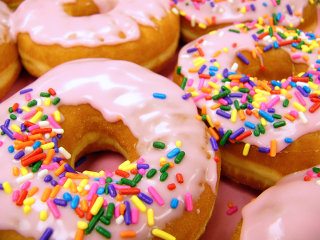Trans Fat
Most (not all) trans fat is man-made. It is created from natural fats by high-heat food manufacturing. It is one of the four kinds of fat (the others are saturated, monounsaturated, and polyunsaturated). The “trans” name refers to the placement of hydrogen atoms in the molecule.

This fat is widely distributed throughout our food supply: in processed food, margarine, and shortening. It is one of the major hazards of processed food.
Nearly all nutritionists now agree that this man-made fat is harmful. For this reason, the FDA requires it to be listed, with the amount per serving, on the “nutrition information” label on packaged foods. The idea is that consumers will police themselves on how much they eat and will pressure manufacturers to use alternatives.
It is not labeled everywhere that it is found, however. The FDA allows the label to read "no trans fat" when there is up to 500 mg. (.5 grams) per serving. Manufacturers adjust the serving size to keep the amount per serving below the cut-off level.
This fat can be at a very high amount in the following kinds of foods, which are typically made with partially hydrogenated oils:
- Margarine
- Shortening
- Junk food
- Fast food
- Commercial fried foods
- Commercial baked goods
- Candy
- Desserts
- Salad dressing
- Restaurant food
Partial Hydrogenation
Partially hydrogenated oils/fats are up to 60% trans. The hydrogenation process takes natural oils—such as soybean oil, cottonseed oil, or canola oil – and transforms them into a fat with characteristics useful to the food industry. The process forms so-called “industrial trans fatty acids."
Manufacturers can use cheap oils like corn or soybean oil when they are partially hydrogenated. Hydrogenation creates a spreadable fat that has the right consistency and texture for baking and battering. It also has a longer shelf life than the original oils (or virtually any natural fat).
The hydrogenation process serves the purposes of the food manufacturer, but degrades the nutrition of the food. It not only destroys the beneficial parts of the oil, it creates a toxic oil.
This fat is linked to many modern diseases:
- Heart disease
- Cancer
- Insulin resistance
- Immune disorders
How can it be so damaging? Because the body incorporates it as if it were a natural fat. It becomes part of the body's cell membranes, but it doesn't act like a natural fat. It disrupts the function of every cell that contains it.
Some of the early research reporting that “fat” is bad was actually done with hydrogenated oils, and thus was actually studying trans fat.
CLA: Natural and Beneficial
There are also natural trans fats that are currently being studied and thought to be actually beneficial. One is conjugated linoleic acid (CLA), which is found in small amounts (1% to 2%) in the fat of meat and milk from cows, goats, and sheep. It is interesting to see that there may be a benefit for a fat from nature but none from man-made fat.
More Information
Soybean Oil: One of the Most Harmful Ingredients in Processed Foods
by Dr. Joseph Mercola, D.O.
The Skinny on Fats
by Mary G. Enig and Sally Fallon